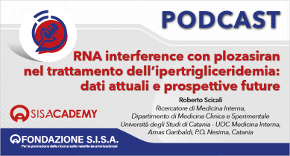 Rivista in lingua italiana
Rivista in lingua italiana
riservata ai Soci SISA
Ultimo numero:
Anno 16 • N.1/2025
SISANews
Una nuova terapia per la Lp(a)
La Lp(a) è un fattore di rischio per le malattie cardiovascolari e per la stenosi calcifica dell'aorta. Si calcola che una concentrazione di Lp(a) nell'intervallo di rischio (250-300 mg/dL) sia molto frequente e interessi il 20-30% della popolazione mondiale. Non ci sono nè mezzi farmacologici, nè mezzi dietetici o comportamentali in grado di interferire in maniera sostanziale sulla concentrazione di Lp(a) che in larga parte è geneticamente determinata. E' in fase di sviluppo un nuovo farmaco, un oligonucleotide antisenso designato a legare selettivamente l'mRNA che codifica per apo(a). Ne deriva una netta riduzione di sintesi di apo(a) e, di conseguenza, della concentrazione plasmatica di Lp(a). La risposta farmacologica appare dose dipendente con un effetto di riduzione che arriva fino a quasi il 40% con le dosi più alte.
![]()
Antisense therapy targeting apolipoprotein(a): a randomised, double-blind, placebo-controlled phase 1 study
Tsimikas S, Viney NJ, Hughes SG, Singleton W, Graham MJ, Baker BF, Burkey JL, Yang Q, Marcovina SM, Geary RS, Crooke RM, Witztum JL
Lancet. 2015;386:1472-83
BACKGROUND: Lipoprotein(a) (Lp[a]) is a risk factor for cardiovascular disease and calcific aortic valve stenosis. No effective therapies to lower plasma Lp(a) concentrations exist. We have assessed the safety, pharmacokinetics, and pharmacodynamics of ISIS-APO(a)Rx, a second-generation antisense drug designed to reduce the synthesis of apolipoprotein(a) (apo[a]) in the liver.
METHODS: In this randomised, double-blind, placebo-controlled, phase 1 study at the PAREXEL Clinical Pharmacology Research Unit (Harrow, Middlesex, UK), we screened for healthy adults aged 18-65 years, with a body-mass index less than 32,0 kg/m(2), and Lp(a) concentration of 25 nmol/L (100 mg/L) or more. Via a randomisation technique, we randomly assigned participants to receive a single subcutaneous injection of ISIS-APO(a)Rx (50 mg, 100 mg, 200 mg, or 400 mg) or placebo (3:1) in the single-dose part of the study or to receive six subcutaneous injections of ISIS-APO(a)Rx (100 mg, 200 mg, or 300 mg, for a total dose exposure of 600 mg, 1200 mg, or 1800 mg) or placebo (4:1) during a 4 week period in the multi-dose part of the study. Participants, investigators, and study staff were masked to the treatment assignment, except for the pharmacist who prepared the ISIS-APO(a)Rx or placebo. The primary efficacy endpoint was the percentage change from baseline in Lp(a) concentration at 30 days in the single-dose cohorts and at 36 days for the multi-dose cohorts. Safety and tolerability was assessed 1 week after last dose and included determination of the incidence, severity, and dose relation of adverse events and changes in laboratory variables, including lipid panel, routine haematology, blood chemistry, urinalysis, coagulation, and complement variables. Other assessments included vital signs, a physical examination, and 12-lead electrocardiograph. This trial is registered with European Clinical Trials Database, number 2012-004909-27.
FINDINGS: Between Feb 27, 2013, and July 15, 2013, 47 (23%) of 206 screened volunteers were randomly assigned to receive ISIS-APO(a)Rx as a single-dose or multi-dose of ascending concentrations or placebo. In the single-dose study, we assigned three participants to receive 50 mg ISIS-APO(a)Rx, three participants to receive 100 mg ISIS-APO(a)Rx, three participants to receive 200 mg ISIS-APO(a)Rx, three participants to receive 400 mg ISIS-APO(a)Rx, and four participants to receive placebo. All 16 participants completed treatment and follow-up and were included in the pharmacodynamics, pharmacokinetics, and safety analyses. For the multi-dose study, we assigned eight participants to receive six doses of 100 mg ISIS-APO(a)Rx, nine participants to receive six doses of 200 mg ISIS-APO(a)Rx, eight participants to receive six doses of 300 mg ISIS-APO(a)Rx, and six participants to receive six doses of placebo. Whereas single doses of ISIS-APO(a)Rx (50-400 mg) did not decrease Lp(a) concentrations at day 30, six doses of ISIS-APO(a)Rx (100-300 mg) resulted in dose-dependent, mean percentage decreases in plasma Lp(a) concentration of 39,6% from baseline in the 100 mg group (p=0,005), 59,0% in the 200 mg group (p=0,001), and 77·8% in the 300 mg group (p=0,001). Similar reductions were observed in the amount of oxidized phospholipids associated with apolipoprotein B-100 and apolipoprotein(a). Mild injection site reactions were the most common adverse events.
INTERPRETATION: ISIS-APO(a)Rx results in potent, dose-dependent, selective reductions of plasma Lp(a). The safety and tolerability support continued clinical development of ISIS-APO(a)Rx as a potential therapeutic drug to reduce the risk of cardiovascular disease and calcific aortic valve stenosis in patients with elevated Lp(a) concentration.

Area Soci
Eventi
39° Congresso Nazionale
 39° Congresso Nazionale
39° Congresso NazionaleRoma, 23-25 novembre 2025
Save the date




 Spring Meeting Gruppi Giovani SID, SIGG, SIIA, SIMI, SIPREC, SISA
Spring Meeting Gruppi Giovani SID, SIGG, SIIA, SIMI, SIPREC, SISARimini, 6-8 aprile 2025
[continua a leggere]
 SISA LIPID ACADEMY - Corso avanzato di lipidologia clinica
SISA LIPID ACADEMY - Corso avanzato di lipidologia clinicaModena, 4-5 Luglio 2024
[continua a leggere]Giornale Italiano Arteriosclerosi
HoFH today
 Rivista Italiana della
Rivista Italiana della
Ipercolesterolemia
Familiare Omozigote
Anno 6 • N.1/2024
Rivista NMCD
Diateca
[continua a leggere]
[continua a leggere]
Newsletter
il vostro indirizzo di posta elettronica
Progetto LIPIGEN

Nuovo sito dedicato al Progetto LIPIGEN
Progetto LIPIGEN - Vecchio portale
E' necessario essere loggati come utente
Lipigen per poter accedere alla pagina
PROject Statin Intolerance SISA
PROSISA – PROject Statin Intolerance SISA
E' necessario essere loggati come utente
PROSISA per poter accedere alla pagina
GILA - Lipoprotein Aferesi
Gruppo Interdisciplinare Lipoprotein Aferesi
(Accesso Gruppo GILA-Lipoprotein Aferesi)
E' necessario essere loggati come utente del Gruppo GILA per poter accedere
Gruppo Interdisciplinare Lipoprotein Aferesi
(Documentazione ad accesso libero)
Pagina informativa per medici e pazienti










